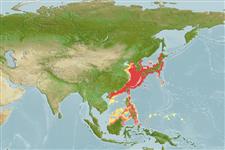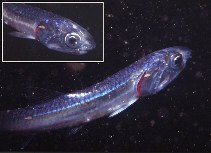把你的觀察加入 Fish Watcher
| Native range | All suitable habitat | Point map | Year 2050 |

|
| This map was computer-generated and has not yet been reviewed. |
| Engraulis japonicus AquaMaps Data sources: GBIF OBIS |
上傳你的 相片 和 影像
Pictures | Google 影像Engraulis japonicus
Picture by Zsilavecz, G.
Pictures | Google 影像Engraulis japonicus
Picture by Zsilavecz, G.
Chinese Taipei (Taiwan) country information
Common names:
[No common name]
Occurrence: native
Salinity: brackish
Abundance: | Ref:
Importance: minor commercial | Ref: FAO, 2000
Aquaculture: | Ref:
Regulations: | Ref:
Uses: live export: yes;
Comments: Known from northern (Tung-hsiao, Hsin-chu and Tai-chung, abundantly found in Shihman and Yehliu (Ref. 43538)) and southern Taiwan (Ref. 43515), and the Taiwan Strait (Ref. 47843). Collected from a mangrove creek in Chu-Wei, northwestern Taiwan (Ref. 48455) and reported from Penghu (Ref. 43515, 55073). Larvae of this species were most abundant in late April off the Tanshui River estuary (Ref. 13680).
National Checklist:
Country Information: https://www.cia.gov/library/publications/resources/the-world-factbook/geos/tw.html
National Fisheries Authority:
Occurrences: Occurrences Point map
Main Ref: Whitehead, P.J.P., G.J. Nelson and T. Wongratana, 1988
National Database: The Fish Database of Taiwan
Occurrence: native
Salinity: brackish
Abundance: | Ref:
Importance: minor commercial | Ref: FAO, 2000
Aquaculture: | Ref:
Regulations: | Ref:
Uses: live export: yes;
Comments: Known from northern (Tung-hsiao, Hsin-chu and Tai-chung, abundantly found in Shihman and Yehliu (Ref. 43538)) and southern Taiwan (Ref. 43515), and the Taiwan Strait (Ref. 47843). Collected from a mangrove creek in Chu-Wei, northwestern Taiwan (Ref. 48455) and reported from Penghu (Ref. 43515, 55073). Larvae of this species were most abundant in late April off the Tanshui River estuary (Ref. 13680).
National Checklist:
Country Information: https://www.cia.gov/library/publications/resources/the-world-factbook/geos/tw.html
National Fisheries Authority:
Occurrences: Occurrences Point map
Main Ref: Whitehead, P.J.P., G.J. Nelson and T. Wongratana, 1988
National Database: The Fish Database of Taiwan
Common names from other countries
分類 / Names 俗名 | 同種異名 | Catalog of Fishes(屬, 種) | ITIS | CoL | WoRMS | Cloffa
Teleostei > Clupeiformes (Herrings) 鯡形目 (Herrings) > Engraulidae (Anchovies) 鯷科 (Anchovies) > Engraulinae
Etymology: Engraulis: Greek, eggraulis, -eos = anchovy (Ref. 45335).
More on authors: Temminck & Schlegel.
Etymology: Engraulis: Greek, eggraulis, -eos = anchovy (Ref. 45335).
More on authors: Temminck & Schlegel.
Environment: milieu / climate zone / depth range / distribution range 生態學
海洋; 海洋洄游的 (Ref. 51243); 深度上下限 0 - 400 m (Ref. 50550). 溫帶; 8°C - 30°C (Ref. 56557); 49°N - 2°N, 105°E - 155°E (Ref. 54432)
分布 國家 | FAO區域 | 生態系 | 發現紀錄 | Point map | 簡介 | Faunafri
Western Pacific: southern Sakhalin Islands, Sea of Japan and Pacific coasts of Japan, and south to almost Canton/Taiwan; rare records (seems to represent stray fishes) off the coasts of Luzon and Western Mindanao, Philippines and from Manado and Ujung Pandang, Sulawesi, Indonesia (Ref. 189).
西太平洋: 南方的薩哈林島, 日本海與日本的太平洋海岸, 而且幾乎南至廣東/台灣; 稀有的記錄 (似乎代表迷途的魚) 外海的呂宋島與西方菲律賓民答那峨的海岸與從 Manado 與 Ujung Pandang ,印尼蘇拉威西.(參考文獻 189)
西太平洋: 南方的薩哈林島, 日本海與日本的太平洋海岸, 而且幾乎南至廣東/台灣; 稀有的記錄 (似乎代表迷途的魚) 外海的呂宋島與西方菲律賓民答那峨的海岸與從 Manado 與 Ujung Pandang ,印尼蘇拉威西.(參考文獻 189)
Length at first maturity / 大小 / 重量 / 年齡
Maturity: Lm 10.5, range 10 - 11 cm
Max length : 18.0 cm TL 雄魚/尚未辨別雌雄; (Ref. 56527); common length : 14.0 cm TL 雄魚/尚未辨別雌雄; (Ref. 56527); 最大體重: 45.00 g (Ref. 56527); 最大年齡: 4 年 (Ref. 56527)
Max length : 18.0 cm TL 雄魚/尚未辨別雌雄; (Ref. 56527); common length : 14.0 cm TL 雄魚/尚未辨別雌雄; (Ref. 56527); 最大體重: 45.00 g (Ref. 56527); 最大年齡: 4 年 (Ref. 56527)
簡短描述 檢索表 | 型態特徵 | 形態測量圖
背棘 (總數) : 0; 背的軟條 (總數) : 12 - 14; 臀棘: 0; 臀鰭軟條: 13 - 18. Differs very little from the European anchovy (see E. encrasicolus) and can be identified from that description. Of other anchovies found in the southern part of its distribution, only species of Encrasicholina and Stolephorus are of similar appearance, but all have small spine-like pre-pelvic scutes (usually 2 to 7 scutes). Thryssa have compressed bodies and a keel of scutes along belly.
與歐洲的鯷魚 (見 E. encrasicolus) 差異很小而且能從那描述被鑑定。 其他鯷魚發現於它的分布的南部了, Encrasicholina 的唯一種與 Stolephorus 是相似外表, 但是全部有小的像棘一樣的前腹鰭鱗甲.(通常 2 到 7個鱗甲) Thryssa 有扁長形的身體,而且一個鱗甲的龍骨脊沿著腹面。
與歐洲的鯷魚 (見 E. encrasicolus) 差異很小而且能從那描述被鑑定。 其他鯷魚發現於它的分布的南部了, Encrasicholina 的唯一種與 Stolephorus 是相似外表, 但是全部有小的像棘一樣的前腹鰭鱗甲.(通常 2 到 7個鱗甲) Thryssa 有扁長形的身體,而且一個鱗甲的龍骨脊沿著腹面。
Occurs in large schools near the surface, mainly in coastal waters but as far out as over 1,000 km from the shore. Tends to move more northward and inshore in spring and summer. Juveniles associate with drifting seaweed (Ref. 12114, 12115). Feeds on copepods, but also on other small crustaceans, molluscan larvae, fish eggs and larvae and diatoms. Marketed fresh and salted, processed into fishmeal and oil (Ref. 12484).
形成大群的魚群接近水表面, 主要在沿岸水域但是遠達超過 1,000 公里距離岸邊。 在春天與夏天傾向移動較北方與沿海地區。 稚魚與漂流的海草聚在一起。 (參考文獻 12114,12115) 吃橈腳類的動物, 也捕食其他的小型甲殼動物,軟體動物的幼生,魚卵與仔魚與矽藻。 在市場上銷售新鮮而鹽醃的, 加工成魚漿或魚油.(參考文獻 12484)
形成大群的魚群接近水表面, 主要在沿岸水域但是遠達超過 1,000 公里距離岸邊。 在春天與夏天傾向移動較北方與沿海地區。 稚魚與漂流的海草聚在一起。 (參考文獻 12114,12115) 吃橈腳類的動物, 也捕食其他的小型甲殼動物,軟體動物的幼生,魚卵與仔魚與矽藻。 在市場上銷售新鮮而鹽醃的, 加工成魚漿或魚油.(參考文獻 12484)
Life cycle and mating behavior 成熟度 | 繁殖 | 產卵場 | 卵 | 孕卵數 | 仔魚
西太平洋: 南方的薩哈林島, 日本海與日本的太平洋海岸, 而且幾乎南至廣東/台灣; 稀有的記錄 (似乎代表迷途的魚) 外海的呂宋島與西方菲律賓民答那峨的海岸與從 Manado 與 Ujung Pandang ,印尼蘇拉威西.(參考文獻 189)
主要參考資料
Upload your references | 參考文獻 | 合作者 | 合作者
Whitehead, P.J.P., G.J. Nelson and T. Wongratana, 1988. FAO Species Catalogue. Vol. 7. Clupeoid fishes of the world (Suborder Clupeoidei). An annotated and illustrated catalogue of the herrings, sardines, pilchards, sprats, shads, anchovies and wolf-herrings. FAO Fish. Synop. 125(7/2):305-579. Rome: FAO. (Ref. 189)
人類使用
漁業: 高經濟性; 養殖: 商業性; 誘餌: usually
FAO(漁業: 產生, 魚種描繪; publication : search) | FishSource | 周邊海洋
更多資訊
Population dynamics
成長參數
Max. ages / sizes
Length-weight rel.
Length-length rel.
長度-頻率
Mass conversion
入添量
豐度
成長參數
Max. ages / sizes
Length-weight rel.
Length-length rel.
長度-頻率
Mass conversion
入添量
豐度
Anatomy
鰓區
Brain
Otolith
鰓區
Brain
Otolith
Physiology
Body composition
Nutrients
耗氧量
游泳類型
游泳速度
Visual pigments
Fish sound
Diseases & Parasites
Toxicity (LC50s)
Body composition
Nutrients
耗氧量
游泳類型
游泳速度
Visual pigments
Fish sound
Diseases & Parasites
Toxicity (LC50s)
工具
Bio-Quiz | E-book | 野外調查 | 檢索表 | 長度- 頻率 Wizard | 生活- 歷史的工具 | 分布圖 | Classification Tree
| Catch-MSY |
特別的報告
下載 XML
網路資源
Aquatic Commons | BHL | Cloffa | BOLDSystems | Websites from users | 檢查 FishWatcher | CISTI | Catalog of Fishes(屬, 種) | DiscoverLife | ECOTOX | Faunafri | Fishtrace | GenBank(基因組, 核甘) | GloBI | GOBASE | | Google Books | Google Scholar | Google | IGFA World Record | MitoFish | 國家資料庫 | Otolith Atlas of Taiwan Fishes | PubMed | Reef Life Survey | Scirus | SeaLifeBase | 樹狀分類階層 | Wikipedia(去, 搜尋) | World Records Freshwater Fishing | Zoobank | 動物學的記錄
Estimates based on models
Preferred temperature (Ref. 115969): 8.1 - 23.3, mean 18.4 (based on 139 cells).
Phylogenetic diversity index (Ref. 82804): PD50 = 0.5020 [Uniqueness, from 0.5 = low to 2.0 = high].
Bayesian length-weight: a=0.00398 (0.00272 - 0.00583), b=3.10 (2.98 - 3.22), in cm Total Length, based on LWR estimates for this species & Genus-body shape (Ref. 93245).
營養階層 (Ref. 69278): 3.1 ±0.1 se; based on diet studies.
回復力 (Ref. 120179): 高度, 族群倍增時間少於 15個月 (K=1.05; tm=1-2; tmax=3).
Prior r = 0.90, 95% CL = 0.60 - 1.36, Based on 3 full stock assessments.
Fishing Vulnerability (Ref. 59153): Low vulnerability (23 of 100).




